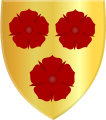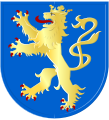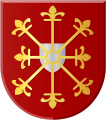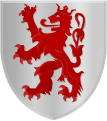House of Wassenberg
| of Wassenberg of Guelders of Cleves of Heinsberg of Falkenburg | |
|---|---|
| Noble family | |
 Coat of Arms | |
| Country | Netherlands Belgium Germany |
| Founded | 11th century |
| Founder | Gerard I Flamens and Rutger I, brothers |
| Final ruler | Agnes, Lady of Heinsberg (in Heinsberg) John, Lord of Falkenburg (in Falkenburg) John, Count of Cleves (in Cleves) Matilda and Maria of Guelders (in Guelders) |
| Estate(s) | County of Guelders Duchy of Guelders County of Cleves Lordship of Heinsberg Land of Falkenburg |
| Dissolution | 1267 (in Heinsberg) 1352 (in Falkenburg) 1368 (in Cleves) 1371 (in Guelders) |
| Cadet branches | House of Cleves House of Heinsberg House of Falkenburg |
The House of Wassenberg (Huis van Wassenberg), was a noble family, active in the area covering parts of the Netherlands and Germany, active from 1021 until 1371. Residing initially at Wassenberg, they expanded rapidly into larger areas, and grew through marriage.
Origins
[edit]The first recorded members of the family are two brothers, Gerard I Flamens and Rutger, sometimes called Rutger von Antoing[1].The first held the main town of Wassenberg, and the other established himself at Kleve[2] in the medieval Hettergau. Rutger or one of his close descendants was already elevated to countship in second half of the 11th-century[3]. Despite that, 1092 is still the most commonly used date to refer to a ruler of Cleves[1].
-
Coat of arms of the County of Guelders.
-
Coat of arms of the Duchy of Guelders.
-
Coat of arms of the County of Cleves.

In 1096, Gerard IV, Lord of Wassenberg, ascended as Gerard I, Count of Guelders[4]. His successor, Gerard II, married Ermengarde, heiress of the Count of Zutphen. By that time, Guelders and Zutphen controlled two different parts of the region of Hamaland, which were joined through this marriage.
In the 12th and 13th centuries, Guelders quickly expanded downstream along the sides of the Meuse, Rhine, and IJssel rivers and even claimed the succession in the Duchy of Limburg, until it lost the 1288 Battle of Worringen against Berg and Brabant.
In 1129, the first settlement of the family at Wassenberg had been given, through marriage, to the Dukes of Limburg, which the Guelders family tried to recover through marriage with Ermengard, heiress of Limburg. However, following the War of the Limburg Succession, Limburg ended up annexed to the Duchy of Brabant. Cleves also participated in this conflict, and helped weaken the powerful Electorate of Cologne.
Relations between the two main branches continued, as in 1355 Guelders gave Zevenaar to the county of Cleves.
In 1339, Reginald II of Guelders was raised to ducal status. But the raise only meant more conflict: the sons of Reginald II confronted each other: the elder son Reginald was imprisoned by he younger one, Edward. As both died without male succession, in 1371 Edward's daughters warred each other for the possession of the duchy. The House of Jülich, through Maria of Guelders, eventually won the dispute.
Even the Cleves branch wasn't meant to last too much long. Upon the death of John of Cleves in 1368, the fief was inherited by his nephew Adolf III of the Marck. Cleves and the Marck were then ruled in personal union by the House of La Marck after Adolf's elder brother Engelbert had died without issue in 1391.
Heinsberg and Falkenburg branches
[edit]-
Coat of arms of the Heinsberg branch.
-
Coat of arms of the Falkenburg branch.
-
Ruins of the Valkenburg Castle.
In 1082, Goswin, a brother of Gerard, first count of Guelders, was invested with the Lordship of Heinsberg. In 1168, in an inheritance division, emerged the Lordship of Falkenburg[5]. One of the most famous members of this branch is Beatrice of Falkenburg, married to the King of the Romans Richard of Cornwall.
At the end of the 12th-century the heiress of Heinsberg married her cousin from Cleves; this kept the lordship within the family, and prolonged it until 1217, when it was inherited by the House of Sponheim. The Falkenburg branch, in turn, went extinct in 1368; their land was inherited by the Van Schoonvorst family.
Rulers
[edit]House of Wassenberg
[edit]Partitions under Wassenberg rule
[edit]| Lordship of Wassenberg (1021-1096) |
Lordship of Cleves (1021-c.1070) Raised to: County of Cleves (c.1070-1368) | ||
| Raised to: County of Guelders (1096-1339) | |||
| Lordship of Falkenburg (1168-1352) (Cleves branch from 1212) |
Lordship of Heinsberg (1082-1267) (Cleves branch from 1217) | ||
| Inherited by the House of Sponheim | |||
| Raised to: Duchy of Guelders (1339-1379) | |||
| Inherited by the Van Schoonvorst family |
Inherited by the House of La Marck | ||
| First War of the Guelderian Succession Won by the House of Jülich | |||
Table of rulers
[edit]| Monarch | Born | Reign | Ruling part | Consort | Death | Notes | |
|---|---|---|---|---|---|---|---|
| Gerard I Flamens | c.980? First son of Rutger of Kamerijk |
1021 – 1042 | Lordship of Wassenberg | Unknown at least one child |
1042 aged 61-62 |
Brothers, divided their domains. | |
| Rutger I | c.980? Second son of Rutger of Kamerijk |
1021 – 1050 | Lordship of Cleves | Wazela of Lorraine two children |
1050 aged 69-70 | ||
| Gerard II Flamens | c.1000? Son of Gerard I |
1042 – 1052 | Lordship of Wassenberg | Liutgard (?) of Hamaland[6] |
1052 aged 51-52 |
||
| Eberhard | c.1000? First son of Rutger I and Wazela of Lorraine |
1050 – 1074 | Lordship of Cleves (at Cleves proper; until c.1070) County of Cleves (from c.1070) |
Bertha at least one child? |
1050 aged 73-74 |
Children of Rutger, divided the inheritance, but it was quickly reunited. | |
| Rutger II | c.1000? Second son of Rutger I and Wazela of Lorraine |
1050 – 1075 | Lordship of Cleves (at Tomburg) |
Unmarried | 1075 aged 74-75 | ||
| Tomberg rejoined Cleves | |||||||
| Gerard III Flamens | c.1022? First son of Gerard II and Liutgard (?) of Hamaland |
1052 – 1075 | Lordship of Wassenberg | Adela (?) of Leuven[7][8] no children |
c.1075 aged 52-53? |
||
| Dirk I | c.1050? Son of Eberhard and Bertha |
1074 – 1092 | County of Cleves | Unknown at least one child? |
1092 aged 41-42 |
||
| Dirk Flamens | c.1025? Second son of Gerard II and Liutgard (?) of Hamaland |
1075 – 19 October 1082 | Lordship of Wassenberg | Unknown three children |
19 October 1082 Bouillon Castle aged 66-67 |
||
| Gerard I Flamens | c.1050? First son of Dirk |
19 October 1082 – 8 March 1129 | Lordship of Wassenberg (until 1096) County of Guelders (from 1096) |
Clementia of Aquitaine 1086 four children |
8 March 1129 aged 78-79 |
Children of Dirk, divided the inheritance. The Lordship of Wassenberg was promoted to County of Guelders in 1096. | |
| Goswin I | c.1050? Second son of Dirk |
19 October 1082 – 1 April 1128 | Lordship of Heinsberg | Oda of Walbeck at least two children |
1 April 1128 aged 77-78? | ||
| Dirk II | 
|
c.1070? Son of Dirk I |
1092 – 1120 | County of Cleves | Unknown at least one child |
c.1120 aged 49-50 |
|
| Arnold | 
|
c.1090? Son of Dirk II |
1120 – 20 February 1147 | County of Cleves | Ida of Leuven c.1120 three children |
c.1120 aged 49-50 |
|
| Gerard | c.1090? First son of Goswin I and Oda of Walbeck |
1 April 1128 – 1129 | Lordship of Heinsberg (in Heinsberg proper) |
Irmgard de Plötzkau four children |
1129 aged 38-39? |
Children of Goswin I, divided the inheritance. | |
| Goswin II | c.1090? Second son of Goswin I and Oda of Walbeck |
1 April 1128 – 8 April 1168 | Lordship of Heinsberg (at Falkenburg until 1129; in Heinsberg proper since 1129) |
Adelaide of Sommerschenburg seven children |
8 April 1168 aged 77-78? | ||
| Gerard II the Long | c.1090 Son of Gerard I and Clementia of Aquitaine |
8 March 1129 – 16 October 1133 | County of Guelders (at Geldern) |
Ermengarde, Countess of Zutphen 1116 three children |
16 October 1133 aged 42-43 |
Children of Gerard I, divided their inheritance. Judith inherited the old seat of the family, which she passed to her own children. In compensation, Gerard's marriage to the heiress of Zutphen brought to Guelders a large amount of other important neighbouring lands. | |
| Judith | c.1087 Daughter of Gerard I and Clementia of Aquitaine |
8 March 1129 – 1151 | County of Guelders (at Wassenberg) |
Waleran II, Duke of Limburg 1107 five children |
1151aged 60-61 | ||
| Wassenberg inherited by the Duchy of Limburg | |||||||
| Henry | 1117 Son of Gerard II and Ermengarde, Countess of Zutphen |
16 October 1133 – 10 September 1182 | County of Guelders | Agnes of Arnstein (d.1171) 1135 five children Lauretta of Flanders 1173? no children |
10 September 1182 aged 42-43 |
||
| Dirk III | c.1125 Son of Arnold and Ida of Leuven |
20 February 1147 – 27 April 1172 | County of Cleves | Adelaide of Sulzbach c.1160 four children |
27 April 1172 aged 46-47 |
||
| Goswin III | 1125 First son of Goswin II and Adelaide of Sommerschenburg |
8 April 1168 – 1180 | Lordship of Falkenburg | Sophia of Saffenberg three children |
1180 aged 54-55? |
Children of Goswin II, divided their inheritance. | |
| Godfrey | c.1130 Fourth son of Goswin II and Adelaide of Sommerschenburg |
8 April 1168 – 1180 | Lordship of Heinsberg (at Heinsberg proper) |
Sophia of Loon (c.1150-12 April 1185) 1171/72 one child |
c.1180 aged 49-50? | ||
| Matilda | 1135 Daughter of Goswin II and Adelaide of Sommerschenburg |
8 April 1168 – 20 January 1189 | Lordship of Heinsberg (at Sommerschenburg) |
Dedi III, Margrave of Lusatia c.1155 six children |
20 January 1189 aged 53-54 | ||
| Sommerschenburg inherited by the House of Wettin | |||||||
| Dirk IV | 
|
c.1160 First son of Dirk III and Adelaide of Sulzbach |
27 April 1172 – 1198 | County of Cleves | Margaret of Holland c.1160 four children |
1198 aged 37-38 |
|
| Goswin IV | 1150 Son of Goswin III and Sophia of Saffenberg |
1180 – 1207 | Lordship of Falkenburg | Judith of Limburg no children |
1207 aged 56-57 |
Left no children. Nominated his cousin Adelaide as his heiress. | |
| Valkenburg briefly annexed to Heinsberg | |||||||
| Adelaide | c.1160 Daughter of Godfrey and Sophia of Loon |
1180 – 1217 | Lordship of Heinsberg (with Lordship of Falkenburg since 1207) |
c.1190 three children |
1217 aged 49-50? |
Spouses, ruled jointly. Arnold, as the uncle of the count of Cleves, was also his regent for a brief period. | |
| Arnold of Cleves | 
|
c.1165 Second son of Dirk II and Adelaide of Sulzbach |
1190 – 1201 | 1201 aged 35-36 | |||
| Otto I | 
|
1150 Son of Henry and Agnes of Arnstein |
10 September 1182 – 30 April 1207 | County of Guelders | Richardis of Bavaria 1184 seven children |
30 April 1207 aged 56-57 |
|
| Regency of Arnold of Cleves, Lord of Heinsberg (1198-1201) | |||||||
| Dirk V Nust | 
|
1185 Son of Dirk IV and Margaret of Holland |
1198 – 24 May 1260 | County of Cleves | Matilda of Dinslaken (d.1224) c.1210 two children Hedwig of Meissen (d.1249) c.1225 four children |
24 May 1260 aged 74-75 | |
| Gerard III | 
|
1185 Son of Otto I and Richardis of Bavaria |
30 April 1207 – 22 October 1229 | County of Guelders | Margaret of Brabant January 1206 four children |
22 October 1229 aged 43-44 |
|
| Dirk I | c.1190 Kleve Son of Arnold of Cleves and Adelaide, Lady of Heinsberg |
1217 – 4 November 1227 | Lordship of Heinsberg (with Lordship of Falkenburg) |
Isolda of Limburg (d.1221) c.1215 three children Beatrice of Kyrburg-Dhaun (d.1240) c.1225 five children |
4 November 1227 Heinsberg aged 36-37 |
||
| Agnes | c.1215 Daughter of Dirk I and Isolda of Limburg |
4 November 1227 – 1267 | Lordship of Heinsberg | Henry I (of Sponheim) 1228 six children |
1267 aged 51-52 |
Children of Dirk I, divided their inheritance. Agnes passed her inheritance to her children, from the House of Sponheim. | |
| Regency of Beatrice of Kyrburg-Dhaun (1227-1236) | |||||||
| Dirk II | 1221 Son of Dirk I and Beatrice of Kyrburg-Dhaun |
4 November 1227 – 15 October 1268 | Lordship of Falkenburg | Bertha of Monschau (1225-20 April 1254) c.1240 three children Adelaide of Loon (1240-1275) c.1260 three children |
15 October 1268 Cologne aged 46-47 | ||
| Heinsberg inherited by the House of Sponheim | |||||||
| Otto II the Lame | 
|
1215 Son of Gerard II and Ermengarde, Countess of Zutphen |
22 October 1229 – 10 January 1271 | County of Guelders | Margaret of Cleves (d.10 September 1251) 1242 two children Philippa of Dammartin 1252 four children |
10 January 1271 aged 64-65 |
|
| Dirk VI of Meissen | 
|
1226 Son of Dirk V and Hedwig of Meissen |
24 May 1260 – 18 March 1275 | County of Cleves | Adelaide of Sponheim-Heinsberg (d.1303) c.1255 six children |
18 March 1275 aged 48-49 |
|
| Waleran the Red | 1254 Son of Dirk II and Bertha of Monschau |
15 October 1268 – 5 September 1302 | Lordship of Falkenburg | Philippa of Guelders (1255-1295) 1270 three children |
15 October 1268 Cologne aged 46-47 |
||
| Reginald I the Bellicose | 
|
1255 Son of Otto II and Philippa of Dammartin |
10 January 1271 – 9 October 1326 | County of Guelders | Ermengarde, Duchess of Limburg 1276 no children Margaret of Flanders 3 July 1286 Namur six children |
9 October 1326 Montfort aged 75-76 |
Fought in the War of Limburgian Succession, but eventually lost his claim. From 1318 he was imprisoned by his own son and heir. |
| Regency of Reginald, heir of Guelders (1318-1326) | |||||||
| Dirk VII | 
|
1256 Son of Dirk VI and Adelaide of Sponheim-Heinsberg |
18 March 1275 – 4 October 1305 | County of Cleves | Margaret of Guelders (d.1287) c.1275 three children Margaret of Habsburg-Kyburg (d.1333) 1290 eight children |
4 October 1305 aged 48-49 |
|
| Dirk III | c.1270 First son of Waleran and Philippa of Guelders |
5 September 1302 – 16 June 1305 | Lordship of Falkenburg | Unmarried | 16 June 1305 aged 34-35? |
||
| Reginald | 
|
1283 Falkenburg Second son of Waleran and Philippa of Guelders |
16 June 1305 – 18 July 1333 | Lordship of Falkenburg | Maria van Boutershem (1287-c.1330) 1303 nine children |
18 July 1333 Monschau aged 49-50 |
|
| Otto | 
|
1278 Son of Dirk VII and Margaret of Guelders |
4 October 1305 – 29 October 1310 | County of Cleves | Adelaide of the Mark (d.1301) c.1300 no children Matilda of Virneburg (d.1360) 1308 one child |
29 October 1310 Horstmar aged 31-32 |
|
| Dirk VIII | 
|
1291 First son of Dirk VII and Margaret of Habsburg-Kyburg |
29 October 1310 – 7 July 1347 | County of Cleves | Margaret of Guelders II (d.1333) 7 May 1308 two children Maria of Jülich (d.1353) 1340 one child |
7 July 1347 Horstmar aged 55-56 |
|
| Reginald II the Black | 
|
1295 Son of Reginald I and Margaret of Flanders |
9 October 1326 – 12 October 1343 | County of Guelders (until 1339) Duchy of Guelders (from 1339) |
Sophia Berthout (d.6 May 1329) 11 January 1311 Roermond four children Eleanor of England May 1332 Nijmegen two children |
12 October 1343 Arnhem aged 47-48 |
|
| Dirk IV | 1310 Second son of Reginald and Maria van Boutershem |
18 July 1333 – 19 July 1346 | Lordship of Falkenburg | Machteld van Voorne 1336 no children |
19 July 1346 Vottem aged 46-47 |
Left no children. The lordship was inherited by his brother. | |
| Regency of Eleanor of England and Dirk IV, Lord of Falkenburg (1343-1344)[9] | |||||||
| Reginald III the Fat | 13 May 1333 First son of Reginald II and Eleanor of England |
12 October 1343 – 1361 24 August – 4 December 1371 |
Duchy of Guelders | Maria of Brabant 1 July 1347 Tervuren no children |
4 December 1371 aged 38 | ||
| John | 1313 Third son of Reginald and Maria van Boutershem |
19 July 1346 – 10 August 1352 | Lordship of Falkenburg | Johanna van Voorne c.1340 no children |
10 August 1352 Monschau aged 38-39 |
Left no children. After his death, the lordship was inherited by the Van Schoonvorst family, but in the midst of a succession war. In 1378 it was eventually annexed by the Duchy of Brabant. | |
| Falkenburg inherited by the Van Schoonvorst family | |||||||
| John | 
|
1293 Second son of Dirk VII and Margaret of Habsburg-Kyburg |
7 July 1347 – 9 December 1368 | County of Cleves | Matilda of Guelders 1348 no children |
9 December 1368 aged 74-75 |
|
| Cleves inherited by the House of La Marck | |||||||
| Edward | 
|
12 March 1336 Second son of Reginald II and Eleanor of England |
1361 – 24 August 1371 | Duchy of Guelders | Unmarried[10] | 24 August 1371 Baesweiler aged 35 |
Captured his brother in a battle at Tiel. After his death, his brother returned. |
| Matilda | 
|
1325 First daughter of Reginald II and Sophia Berthout |
4 December 1371 – 24 March 1379 | Duchy of Guelders (claimants against each other) |
Godfrey, Count of Loon-Heinsberg 1336 no children John, Count of Cleves 1348 no children John II, Count of Blois 14 February 1372 no children |
21 September 1384 Huissen aged 58-59 |
First War of the Guelderian Succession, between the two half-sisters of Reginald III and Edward[11]. Maria and her family were the victors. |
| Maria | 6 May 1329 Second daughter of Reginald II and Sophia Berthout |
William II, Duke of Jülich 25 December 1362 three children |
12 May 1405 aged 76 | ||||
| Guelders inherited by the House of Jülich | |||||||
References
[edit]- ^ a b Biographie, Deutsche. "Kleve - Deutsche Biographie". www.deutsche-biographie.de (in German). Retrieved 2024-02-11.
- ^ According to the Annales Rodenses, in Flandriensi provintia duo nobiles germani fratres (...) alter Gerardus et alter (...) Rutgerus. See Annales Rodenses, MGH SS XVI, p. 689.
- ^ Eberhard was referenced as Count of Cleves at least in 1074: Euerhardus comes Clivensis et matrona nobilis Berta comitissa uxor sua. See Kremer (1776), Band II, VIII, p. 203.
- ^ In 1096 a document named Gerardi comitis de Gelre et fratris eius Henrici. See Miraeus (1723), Tome I, LXVII, p. 77.
- ^ Monumentenboek Land van Valkenburg
- ^ Suggested name as her grandmother was Liutgard of Flanders
- ^ The Genealogica ex Stirpe Sancti Arnulfi descendentium Mettensis indicates that the daughters of Henry I of Leuven (one of which the wife of Gerard) were named Adela, Adelaide or Cunigunde.
- ^ (in Latin) Monumenta Germanica Historica, Scriptores, tomus XXV: Genealogica ex Stirpe Sancti Arnulfi descendentium Mettensis, par. 4, pag. 383 Archived 2018-09-04 at the Wayback Machine
- ^ J.P. Arend, Algemene geschiedenis des vaderlandsche van de vroegste tijden tot op heden, Volume III, edited by J.F. Schleijer. Amsterdam, 1844. 'blz VII - blz 210
- ^ Between 1369 and 1371 Edward was engaged to Catharina of Bavaria, but the groom died before the marriage.
- ^ Dimphéna Groffen, Mechteld van Gelre, in: Digitaal Vrouwenlexicon van Nederland. URL: https://resources.huygens.knaw.nl/vrouwenlexicon/lemmata/data/Mechteld van Gelre [20/01/2020]
External links
[edit]- Marek, Miroslav. "Geldern-Heinsberg". Genealogy EU.
- Monumentenboek Land van Valkenburg
Bibliography
[edit]- Jackman, Donald C. (2013). Gerhard Flamens (Part Two). Editions Enlaplage. ISBN 9781936466641.
- Stein, Robert (2017). Magnanimous Dukes and Rising States: The Unification of the Burgundian Netherlands, 1380-1480. Oxford University Press. p. 87. ISBN 9780198757108.






